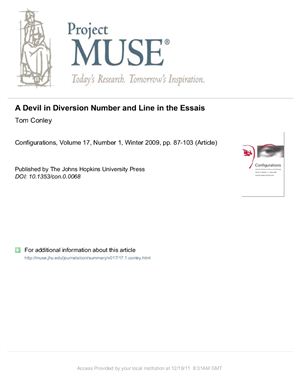Configurations.
Volume 17, Numbers 1-2, Winter 2009.
pp. 87-103.
Subject Headings:
Montaigne, Michel de, 1533-1592. Essais.
Abstract:
A close reading of chapters 3 and 4 of the third volume of Montaigne's Essais reveals that within the lexical matter, there is a strategic deployment of mathematical and geometrical signs. Words and their spacings are literally riddled with numerical forms that reorient—and even multiply—the vectors of meanings of the essays themselves. Gematria becomes a working principle of the chapters that draw attention to the force of their form. In the Essais, arithmetic and geometry are not used metaphorically, but instead inform the verbal texture and belong to the strategies at work in the printed writing. Study of the paired essays "De trois commerces" and "De la diversion" argues that what Montaigne calls his "poetical allure" belongs in strong part to a style built upon the sight and sound of mathematical ciphers. In chapter 3, Montaigne's tower is seen twisting and moving by way of numbers inhering in the signifiers; and in chapter 4, the art of diversion uses distraction and detour to serve as a means to cope with melancholy.
Volume 17, Numbers 1-2, Winter 2009.
pp. 87-103.
Subject Headings:
Montaigne, Michel de, 1533-1592. Essais.
Abstract:
A close reading of chapters 3 and 4 of the third volume of Montaigne's Essais reveals that within the lexical matter, there is a strategic deployment of mathematical and geometrical signs. Words and their spacings are literally riddled with numerical forms that reorient—and even multiply—the vectors of meanings of the essays themselves. Gematria becomes a working principle of the chapters that draw attention to the force of their form. In the Essais, arithmetic and geometry are not used metaphorically, but instead inform the verbal texture and belong to the strategies at work in the printed writing. Study of the paired essays "De trois commerces" and "De la diversion" argues that what Montaigne calls his "poetical allure" belongs in strong part to a style built upon the sight and sound of mathematical ciphers. In chapter 3, Montaigne's tower is seen twisting and moving by way of numbers inhering in the signifiers; and in chapter 4, the art of diversion uses distraction and detour to serve as a means to cope with melancholy.

